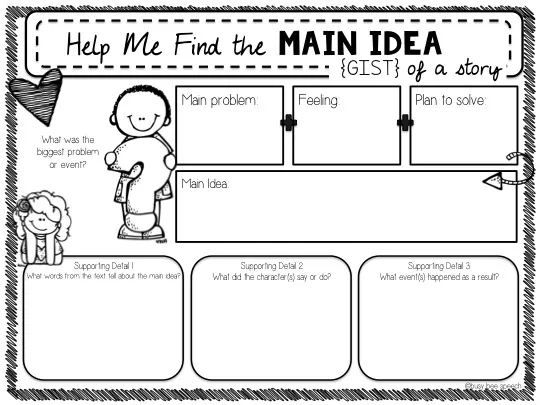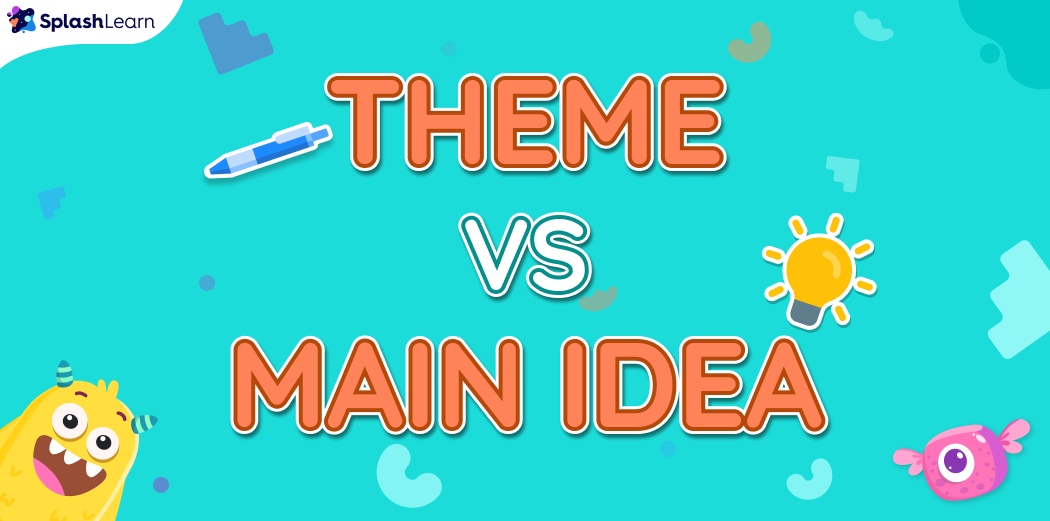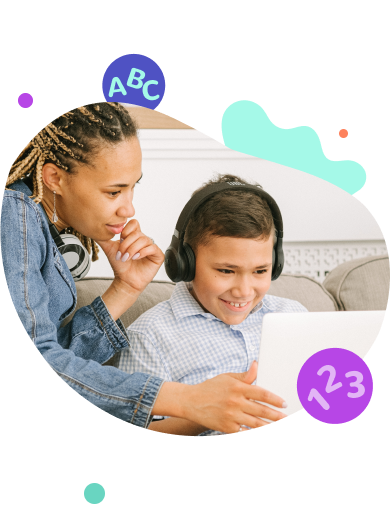Students mix up theme vs main idea all the time. Ask them what a story is about, and they might give a theme instead of a main idea. Or, they might confuse a lesson with the topic of a passage.
Math & ELA | PreK To Grade 5
Kids see fun.
You see real learning outcomes.
Watch your kids fall in love with math & reading through our scientifically designed curriculum.
Parents, try for free Teachers, use for free
This confusion is common, and it makes reading comprehension harder. Teachers see this problem in every grade. Some students read well but struggle to explain what a passage really means. Others pick a theme too quickly without looking at the whole story.
A student once read The Tortoise and the Hare and said the main idea was “Slow and steady wins the race.” That’s not the main idea—it’s the theme! The main idea would be: The tortoise and the hare run a race, and the tortoise wins because he keeps going while the hare gets distracted.
This mix-up happens often, but it can be fixed. The key is to teach both concepts clearly and give students lots of practice. This blog will break down the theme vs main idea in a simple way. It will include definitions, examples, and strategies that work in the classroom.
What is the Main Idea?
The main idea is what a text is mostly about. It is the central point or key message that the author wants to convey.
Examples of main ideas:
- A passage about the different planets in the solar system → Main Idea: The solar system has eight planets, each with unique characteristics.
- A story about a boy training for a marathon → Main Idea: Hard work and perseverance are necessary to achieve goals.
- An article explaining how bees help pollinate flowers → Main Idea: Bees play an important role in the growth of plants.
Understanding the main idea is the first step. Next, let’s explore the theme, which is different from the main idea but just as important.
What is a Theme?
The theme is the deeper message, moral, or life lesson in a story. It is not about what happens in the story but what the story teaches.
Examples of themes:
- “Perseverance leads to success” – A character keeps trying despite failures and eventually achieves their goal.
- “Honesty is the best policy” – A character tells the truth, even when it is difficult, and it leads to a good outcome.
- “Friendship can overcome differences” – Two unlikely friends learn to accept each other despite their differences.
Theme vs. Main Idea: Key Differences
Students often wonder, are theme and main idea the same? No, they are not. While both help us understand a text, they serve different purposes.
Let’s understand the difference between main idea and theme with the table below:
| Feature | Main Idea | Theme |
|---|---|---|
| Scope | Specific to the text | Universal and applies to many stories |
| Explicit or Implicit? | Often directly stated | Usually implied, it must be inferred |
| Where to Find It? | Found in a sentence summarizing the text | Understood through character actions, events, and outcomes |
| Common Keywords | “about,” “explains,” “focuses on” | “lesson,” “moral,” “message,” “life lesson” |
Questions to Identify the Main Idea and Theme

Students often struggle to find the main idea and theme because both require careful reading. Asking the right questions helps them separate what the text is about from what it teaches. Here are some simple questions to guide them:
Questions to Find the Main Idea
- What is the text mostly about?
- Look at the overall topic and key details.
- What details are repeated throughout the passage?
- Important details are often mentioned more than once.
- What does the title suggest about the content?
- Titles often hint at the main idea.
- What is the most important point the author is making?
- Focus on the central message the text is trying to explain.
Questions to Find the Theme
- What lesson does the character learn?
- Themes are often based on a character’s growth or change.
- How do the events in the story relate to real life?
- Themes are universal, meaning they apply outside the story.
- What big idea is explored in the story?
- Think beyond the plot—what does the story say about life?
- If I had to express the story’s message in one sentence, what would it be?
- A theme should be a broad, meaningful statement, not a summary.
By teaching students to ask these questions, they can better understand the difference between theme and main idea. Next, let’s look at practice exercises that reinforce these skills.
Examples and Practice Exercises to Teach Theme vs. Main Idea
Students learn best when they see the difference between theme and main idea in action. The more they practice, the clearer it becomes. Here are three engaging examples to use in class.
Example 1
Passage: A young girl trains every day for a spelling bee. Despite multiple failures, she keeps practicing until she finally wins.
📌 Main Idea: The story is about a girl preparing for and winning a spelling bee.
🎯 Theme: Hard work and persistence lead to success.
✅ How to Teach It:
- Ask students: What happens in the story? (This leads to the main idea.)
- Then ask: What lesson does this teach? (This leads to the theme.)
- Connect to real life: Have you ever worked hard for something? What did you learn?
Example 2
Passage: A dog and a cat, natural enemies, find themselves stranded together in the wild. They learn to trust each other to survive.
📌 Main Idea: A dog and a cat must work together to survive in the wild.
🎯 Theme: Friendship can overcome differences.
✅ How to Teach It:
- Have students explain the facts of the story (main idea).
- Then, ask: What message does this send about friendships? (theme).
- Encourage discussion: Can we think of real-life situations where unlikely friendships happen?
Example 3
Passage: A boy lies to his friends repeatedly. Eventually, they stop trusting him.
📌 Main Idea: A boy loses his friends because he keeps lying.
🎯 Theme: Honesty is important for maintaining relationships.
✅ How to Teach It:
- Let students retell the story in one sentence (main idea).
- Ask: What does this teach us about honesty? (theme).
- Relate it to their world: Why is trust important in friendships?
Give students short passages and have them identify both the main idea and theme. Pair them up to explain their reasoning—peer discussions solidify understanding! Here are some free printable worksheets with engaging passages, guiding questions, and graphic organizers to help students confidently master key details, main idea, and theme. Perfect for classroom use!
Begin here
4 Activities to Teach Theme and Main Idea to Kids
1. Theme vs. Main Idea Sorting Game
This sorting game is a simple, hands-on activity to help students understand the difference between theme and main idea in a fun way.
How to Play the Game
- Create flashcards with examples of main ideas (specific to a text) and themes (universal lessons).
- Divide the class into small groups or pairs and give each group a set of mixed cards.
- Provide two labeled spaces: Theme and Main Idea.
- Students read each card and sort it into the correct category while explaining their choice to their group.
💡 Use the printed cards as a station activity or a warm-up exercise for class discussions!
2. “What’s the Message?” Challenge
Engage your students in an interactive challenge by giving them short stories and asking two key questions:
- “What’s the main idea?”
- “What’s the theme?”
How to Use the Worksheets
Begin here
Print the provided worksheets and distribute them to your class. Each worksheet includes:
- A short passage for students to read.
- Questions that guide them to identify the main idea and theme.
- Space for students to explain their answers in their own words.
3. Story Mapping
Story mapping is a visual and engaging way to help students break down a story’s elements to uncover the main idea and theme.
How to Use Story Mapping-
- Provide students with a story map template. It should include sections for:
- Characters
- Setting
- Key Events
- Problem/Conflict
- Solution/Resolution
- Main Idea
- Theme
- Give students a short story or passage.
Instructions:
- Students will complete each section of the story map as they analyze the story.
- After filling in the basic elements (characters, setting, etc.), they will write:
- Main Idea: What the story is mostly about.
- Theme: The lesson or message the story teaches.
- Encourage students to use evidence from the story to support their answers.
💡 Use this activity as a group project or independent work. Display completed story maps on a bulletin board for a great visual review!
4. Online Games
Learning doesn’t have to be boring! Adding theme vs main idea games to your lesson plan is a fantastic way. Here are some fun free games where kids will identify what is the theme of a passage and what is the main idea:
Begin here
💡Use games as warm-ups to start the lesson with energy or as a wrap-up activity for review.
💡Pair students up to encourage collaboration or make it competitive with individual scores.
💡Assign games as homework practice for extra skill-building outside the classroom.
4 Tips for Students to Identify Theme vs Main Idea
Helping students differentiate between theme and main idea takes practice, patience, and clear guidance. As teachers, we know that these concepts can be tricky, but with the right tips and strategies, students can master them. Here are some tried-and-tested techniques that work in the classroom:
1. Start with the Right Questions
- Teach students to ask:
- “What is the text about?” This leads to the main idea.
- “What lesson does it teach?” This uncovers the theme.
This simple distinction helps them stay focused and reduces confusion.
2. Use Context Clues to Find the Main Idea
- Encourage students to look for hints in:
- The title: Titles often reveal what the text is mostly about.
- Repeated words or ideas: These are clues to the main idea.
- First and last sentences: These often summarize the key point.
Context clues are powerful tools for identifying the main idea quickly and accurately.
3. Explain the Scope: Themes Are Broad, Main Ideas Are Specific
- Clarify the difference by emphasizing:
- Main idea is specific and tied to one text.
- Theme is broad and can apply to multiple stories.
For example:
- Main Idea: A boy trains for a race and wins.
- Theme: Hard work leads to success.
This comparison makes the distinction clearer for students.
4. Use Sentence Starters to Test Their Answers
- If students can start their sentence with:
- “The story is about…” → It’s likely the main idea.
- “The story teaches us…” → It’s likely the theme.
This simple test works like magic in helping students frame their thoughts correctly.
By teaching these tips and focusing on what works, students will confidently distinguish theme vs main idea—a skill they’ll use across all subjects!
Related Reading: Best Reading Comprehension Activities & Games for Kids
Conclusion
Understanding the difference between theme vs main idea is essential for developing strong reading comprehension skills. With clear guidance, engaging activities, and tools like a theme vs main idea anchor chart, students can confidently identify both concepts. These strategies not only make learning fun but also help students connect deeper meanings to what they read.
Related Reading: How to Teach Summarizing
Frequently Asked Questions (FAQ)
Is the central idea the same as the main idea?
Yes, the central idea and main idea are essentially the same. Both refer to what the text is mostly about or its primary point.
Is theme another word for main idea?
No, theme and main idea are different. The main idea explains what the text is about, while the theme conveys the deeper message or life lesson.




































